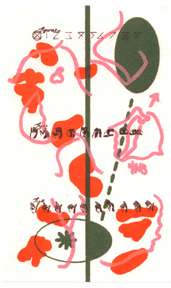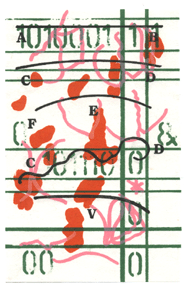
Where the Visual Meets the Verbal
Robert Miltner
continued . . .
![]()
Readings in the Gallery: Postmodern Collaborations

There was a similar alliance of poets and painters again in the 1950s and 1960s during the early years of postmodernism, represented by the New York School which included poet Frank O'Hara and painter Mike Goldberg. Frank O'Hara's poem "Why I Am Not a Painter" shows the differences  between mediums of painting and writing, though it perhaps even more clearly elucidates the similarities. For, though Mike Goldberg is painting and O'Hara is writing, two different creative activities, O'Hara identifies the commonalities of the process: in each case, the artist (visual and verbal) begins with a concept, sardines for Goldberg and oranges for O'Hara; in each case, "days go by" as the process of creating takes place; and in each case, the artist's work—the painting and the poem—deletes the sardines and oranges respectively, yet each artist titles his work similarly, as O'Hara points out in "Why I Am Not a Painter":
between mediums of painting and writing, though it perhaps even more clearly elucidates the similarities. For, though Mike Goldberg is painting and O'Hara is writing, two different creative activities, O'Hara identifies the commonalities of the process: in each case, the artist (visual and verbal) begins with a concept, sardines for Goldberg and oranges for O'Hara; in each case, "days go by" as the process of creating takes place; and in each case, the artist's work—the painting and the poem—deletes the sardines and oranges respectively, yet each artist titles his work similarly, as O'Hara points out in "Why I Am Not a Painter":
|
The poem sets up a comparison between the "simultaneous, parallel, and continuing process" of the two practices which shows O'Hara and Goldberg "engaged in a kind of dialogue with their work," as demonstrated by O'Hara's "workmanlike attention to the mechanics of creation and a shared enthusiasm for them" (Ferguson 24). The collaborative dialogue between Goldberg and O'Hara was not limited to them alone. In the New York art scene of the early 1950s, comprised of painters (Grace Hartigan, Larry Rivers, and Joan Mitchell) and poets (John Ashbery, Barbara Guest, and James Schuyler) who had come of age during the modern period, dialogue between visual and verbal artists was active. "The poets," recalled artist Mike Goldberg, "were the only ones who wrote serious criticism of our work" (Ferguson 42), while "The painters," said O'Hara, "were the only generous audience for our poetry, and most of us read first publicly in art galleries" (Ferguson 43). One distinct aspect of the ekphrastic collaboration associated with the New York School poets and painters is that both collaborators were alive and actually conversing during the collaborative process, adding a dimension to the dialogue which is unavailable when the painter is deceased and all the dialogue takes place between the poet and the object product of the painter's process. This on-going discussion during the process of ekphrastic collaboration is evident in the work of contemporary poet Robert Creeley.
|
Copyright © Enculturation 2001 |